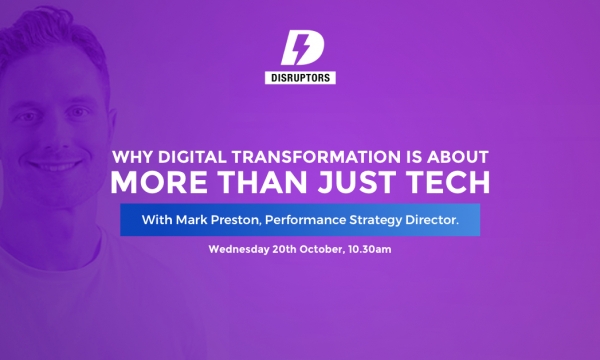What will marketers be embracing in 2018 and beyond? What are they excited about, what will they be worried about and just what will shape their long-term strategies over the course of the coming year? We went around the Stickyeyes office to get an idea of what our team thinks will be the big talking points.
The year of attribution
 With Google on the verge of releasing Google Attribution to the masses, 2018 is looking to be the year where attribution (finally) becomes a truly actionable methodology. Not only will paid & organic channels alike be able to see the true value of marketing campaigns, but they’ll be able to adapt campaigns based on real data and see the benefits in the results.
With Google on the verge of releasing Google Attribution to the masses, 2018 is looking to be the year where attribution (finally) becomes a truly actionable methodology. Not only will paid & organic channels alike be able to see the true value of marketing campaigns, but they’ll be able to adapt campaigns based on real data and see the benefits in the results.
Gaining access to this could lead to the shift in reporting from ‘last click’ to various different attribution models, depending on the industry and channel. Brand awareness campaigns can be more accurately and properly reported from a first click prospective, highlighting the true value of that activity, rather than it being lost in the more commonly used ‘last click’ model.
Jonny Briggs, Data and Analytics Manager
 We’ll see attribution become a real core element of biddable media strategy. As brands try to squeeze more out of their online investment, attribution will show the true value of biddable media and as a result, it will really drive itself up the agenda.
We’ll see attribution become a real core element of biddable media strategy. As brands try to squeeze more out of their online investment, attribution will show the true value of biddable media and as a result, it will really drive itself up the agenda.
More and more advertisers will start to test data driven attribution approaches across Google, which will give leverage to increased activity on Google Shopping and generic keywords. This will be in full flow by the time we hit key shopping dates, such as Black Friday, and retailers will have much more incentive (and a much stronger business case) to push their online activity.
Simon Wilson, Biddable Media Manager
Big investment in DMPs

Brands will be looking to adopt and heavily invest in DMPs (Data Management Platforms) to make better use of the vast amount of first, second (‘shared’, first-party data) and third-party data at their disposal.
That ‘old’ buzzword ‘Big Data’ will actually become more meaningful. DMPs will empower marketers to create vast segmentation models way beyond what we have seen before. This in turn will lead to improved personalisation, as brands look to land the right message, with the right audience, at the right time in the right place (AKA, marketing utopia).
Demand for greater ROI and cost efficiencies, which CMOs are increasingly under pressure to find, will increase the investment in DMPs for brands rich in data and they will become the central platform for planning, buying and executing media as well as finding new insights to feed back through the process.
The challenge for marketers is getting the business cases nailed, a test plan in place, ensuring that the strategy is sharp and verifying that the data going into the system is of the finest quality. Don’t forget to have both eyes on GDPR compliance through your Data Protection Officer, also appearing in 2018.
Adam Culkin, Account Director
Marketplace Optimisation the next big battleground
 In 2018 Marketplace Optimisation (MPO) will become a much bigger priority for eCommerce brands. Most already sell through marketplaces but few brands have dedicated teams or agencies working on strategies to improve visibility.
In 2018 Marketplace Optimisation (MPO) will become a much bigger priority for eCommerce brands. Most already sell through marketplaces but few brands have dedicated teams or agencies working on strategies to improve visibility.
It’s not a term that everyone is familiar with yet, or indeed one that has a common name – you might have seen it referred to as “eRetail” or, when considering the largest marketplace, “SEO for Amazon”. The latter though skims the surface, with other significant online marketplaces such as AliExpress, Alibaba, TaoBao, Rakuten as well as perhaps more well know household names in Europe like eBay, Etsy and the Apple Store all key players.
Why are they so significant? Well, Marketplaces are increasingly becoming the starting point for product searches. A study by technology company Kenshoo suggests that 56% of US, UK, German and French shoppers use Amazon as a starting point for their search, so the assumption that online product search tends to start with Google is now incorrect.
So can brands take their learnings from SEO and apply them to MPO? To a degree yes; content optimisation is part of the solution. But MPO’s all have different algorithms so unlike SEO, where you can largely optimise a site to keep Google happy, in MPO you need to consider the requirements of each Marketplace individually.
There will be common factors across the board, such as delivery speed, pricing, reviews and ratings, and the quality of a product description. But just as important as how good you look on the “digital shelf” is the customer service that you offer. Marketplaces, like search engines, want to protect their reputation and they’re going to favour those retailers that help them to do just that.
If you don’t have an MPO strategy it’s worth putting it on your Christmas list.
Glen Conybeare, Chief Commercial Officer
We’re going to hear a lot more about brand protection….
 The issue of brand protection and reputation management isn’t going to go away. High profile brands pulled ad campaigns from various channels in 2017, and we seem to be at something of a crossroads as to where respectively go from here.
The issue of brand protection and reputation management isn’t going to go away. High profile brands pulled ad campaigns from various channels in 2017, and we seem to be at something of a crossroads as to where respectively go from here.
At the moment, brands are being asked to balance the risk against the reward. Nobody wants to become 2018’s case study of “how not to do digital media buying”, and it is creating an environment where CMOs are understandably nervous about where they deploy content, and what they, knowingly or otherwise, align their brand to.
Ad platforms simply can’t keep up with the sheer volume of content that they are being expected to monitor, but the onus is on them to ensure that the tools and mechanisms that they provide to help brands ensure that they aren’t being associated with content that they really don’t want to be associated with.
And it is then up to advertisers to make sure that they understand these tools, and the way forward to ensure that their digital ad strategy is a success, rather than a reputational disaster.
Jasmine Kendal, Digital CRM Manager
 Corporate social responsibility is also going to be a bigger deal in 2018.
Corporate social responsibility is also going to be a bigger deal in 2018.
Over the past year we’ve seen big brands get behind good causes, such as Smirnoff’s equalising music campaign dedicated to promoting equal gender representation in electronic music. Now, more than ever, people expect brands to use their influence and marketing budgets to help drive positive change in the world. This year’s Edelman Trust Barometer reveals a sharp drop in trust across the board, including business, media and government.
This means that brands are going to have to work harder in 2018 to regain this trust, whether this is through valuable customer service interactions over social media to aligning themselves with a cause that matters to people with a stake in their brand.
Scott Malthouse, PR Team Manager
Final call to be mobile ready
 This will be the year that brands really need to start taking their mobile offering seriously.
This will be the year that brands really need to start taking their mobile offering seriously.
We’ve been waiting long enough for the mobile-first index, but it is coming and it will mean that it has never been more important for brands who have not done so already ensure their website conforms to best practice for mobile devices.
When the mobile first index goes fully live, those brands who have neglected their mobile offering will see drastic changes to their performance within the organic SERPS. It’s time to ensure that your mobile website is consistent in serving the same information and user experience across both your desktop and mobile versions whilst also ensuring the technical architecture conforms to best practice.
Remember – load time on mobile is extremely important for success in the SERPS, if your mobile site is loading much slower than your desktop version then it’s likely to be a big issue on the launch of the mobile first index. Brands may wish to embrace the ever-growing web technology AMP (Accelerated Mobile Pages) to help keep load times to a minimum.
Steve Chambers, SEO Manager
Beware of “Tech Terrorism”
 Big brands and organisations are now potentially at the mercy of so-called “tech terrorism”, as they become bigger targets for malicious activity.
Big brands and organisations are now potentially at the mercy of so-called “tech terrorism”, as they become bigger targets for malicious activity.
How consumers respond to this will be interesting. We keep reading reports of high-profile data breaches, but does that genuinely influence consumer behaviour? Are they simply becoming desensitised to the problem, assuming that there’s nothing that they can do and that big brands are all as bad as each other when it comes to data protection, or will this genuinely become a growing concern which will influence purchasing decisions? Is the age of instant digital consumerism shaping how much consumers actually care about their data, as long as they get what they want?
How brands interpret that question will ultimately determine how they approach the issue. Will brands be prepared to put convenience over security? And will they put a greater focus on a carefully stage-managed PR communications response should a breach occur, in the hope that a reassuring voice will win customers back?
Leo Law, Head of Digital Consultancy
GDPR isn’t the only legislation that should be on your agenda
 By now, you should all be aware of GDPR, and the impact that it is likely to have on your business. While that will undoubtedly be the biggest piece of digital legislation in 2018, don’t expect it to be the only one that will come in and create challenges.
By now, you should all be aware of GDPR, and the impact that it is likely to have on your business. While that will undoubtedly be the biggest piece of digital legislation in 2018, don’t expect it to be the only one that will come in and create challenges.
One particularly interesting development is the introduction of the ‘single digital market’. The European Union wants to put an end to digital geo-blocking, whereby online consumers in one country cannot buy goods or service sold in another, and it wants to do that by the end of 2018.
While this opens new revenue opportunities, it also presents a series of new considerations for SEO specialists.
Lee Allen, Planning Director
The growth of visual search
 Visual search has been a hot topic for a while now and it has been one of those things that existed but hasn’t really been utilised – largely because it wasn’t very good. However, the technology is now starting to come of age and, given how social media has helped image content become so embedded in our digital lives, we are likely to see some big progress in this area.
Visual search has been a hot topic for a while now and it has been one of those things that existed but hasn’t really been utilised – largely because it wasn’t very good. However, the technology is now starting to come of age and, given how social media has helped image content become so embedded in our digital lives, we are likely to see some big progress in this area.
Google is pushing this hard with the Pixel and Assistant application, having ditched Google Glass, and it wouldn’t surprise me to see competitors such as Apple come up with their own form of “Siri-Vision” for visual search.
I think 2018 has the potential to be the year we really start to consider how visual search is a part of the overall SEO strategy. Considering how searchers are consuming visual content and how search engines must now go beyond text and copy to deal with this emerging trend.
Jack Minot, SEO Lead
 People do everything on the go now. Having the ability to look for something you have just seen while walking in the street, in the showroom or in a magazine without having to type or trying to find out the brand, or product name is a perfect way to answer to those “I want to buy” moments.
People do everything on the go now. Having the ability to look for something you have just seen while walking in the street, in the showroom or in a magazine without having to type or trying to find out the brand, or product name is a perfect way to answer to those “I want to buy” moments.
Fashion retailers already started to offer this option and many apps like Snap Fashion or Style Eyes allow people to find retailer offering the product (or similar ones) they just took a snap of.
It makes shopping much more impulsive: Like it, snap it, buy it.
Marion Meudal, EMEA Digital Analyst
Content marketers will invest more in the long-form
 The onus next year will be on creating quality long form content. As top bloggers begin to slow down the amount of times they click publish, brands may follow suit.
The onus next year will be on creating quality long form content. As top bloggers begin to slow down the amount of times they click publish, brands may follow suit.
Pouring more time into producing a handful of meaty and well-written pieces, rather than a constant stream of average work, will pay-off.
Becky Baines, Senior Writer
 Content producers will need to start thinking much more about that all-important “value exchange”. Your brand is just one of thousands who are vying for the attention of your audiences, your audiences have less time to devote to you, and even less inclination to devote that time to content that doesn’t serve their needs.
Content producers will need to start thinking much more about that all-important “value exchange”. Your brand is just one of thousands who are vying for the attention of your audiences, your audiences have less time to devote to you, and even less inclination to devote that time to content that doesn’t serve their needs.
We still see brands data walling or putting a turnstile on content that really has no need to be data walled. We still see brands making it too difficult for audiences to get what they actually want from their content, and we still see brands opting for quantity over quality. That must surely stop.
Brands will need to become even more intelligent at mapping content to the many customer journeys (note the plural) that their audiences take and ensure that their content offers real value at each stage.
Michael Hewitt, Content Marketing Manager
Time to start minding the skills gap
 There will (or at least, there should) be a much bigger effort to address the UK’s £63bn skills gap.
There will (or at least, there should) be a much bigger effort to address the UK’s £63bn skills gap.
The pace of innovation is going to keep accelerating, the coming years are going to bring new challenges when it comes to recruiting talent and so it’s incumbent on organisations to invest in skills and people if we are to stop that skills gap becoming a skills chasm.
We’ve seen some good progress made in quality digital apprenticeships in recent years, and I can see these moving much further up the agenda in 2018.
Laura Dugdale, Group HR Manager
Augmented reality will go mainstream
 We will see a new step forward for the convergence of augmented reality and search. The release of AR Kit and AR Core by Apple & Google provides a deeper integration for apps and the traditional customer journey.
We will see a new step forward for the convergence of augmented reality and search. The release of AR Kit and AR Core by Apple & Google provides a deeper integration for apps and the traditional customer journey.
Until 2017, augmented reality has been rather fragmented and with the launch of iOS11, Google Oreo and the integration into progressive web apps, marketers and developers will need to start exploring the potential of the emerging technologies and untie the digital experience with physical world.
Matt Barnes, SEO Performance Manager
 Ever since Pokémon Go became the new, ermm, Pokémon, AR has been floated as the next big innovation. Facebook has teased us with potential features at their Keynote, SNAP continues to innovate and Lens / Filters are commonplace in any social platform.
Ever since Pokémon Go became the new, ermm, Pokémon, AR has been floated as the next big innovation. Facebook has teased us with potential features at their Keynote, SNAP continues to innovate and Lens / Filters are commonplace in any social platform.
In 2018, I expect the innovation to start thinking more commercially and finding ways to monetise the technology, whilst balancing the need to avoid intrusion. Think VR codes but with much more interactivity. The immersive and reactive nature of this technology will open up completely new avenues of story-telling potential.
Will Conboy, Head of Marketing Communications
Voice search will change how brands approach SEO
 How many Amazon Alexa and Google Home devices will be under the Christmas tree this year? We expect that Santa’s sack will be bulging with smart speakers and personal assistants in 2017, and that is going to make search much more vocal in 2018.
How many Amazon Alexa and Google Home devices will be under the Christmas tree this year? We expect that Santa’s sack will be bulging with smart speakers and personal assistants in 2017, and that is going to make search much more vocal in 2018.
The ubiquity of smart devices will push voice search up the agenda, and SEO strategies will need to adapt. Brands will need to think much more carefully about semantics, about conversational conventions and regional nuances than they typically would need to with text-based search.
And as the search engines get smarter, and gather more data about how consumers use the technology, it will be those brands that can really understand the intent of a user’s query that will get the result.
Michael Hayden, SEO Lead
Position zero gets even more powerful
 My prediction for 2018 is that Google will refine their featured snippet and answer boxes even further.
My prediction for 2018 is that Google will refine their featured snippet and answer boxes even further.
Google has already started testing animated thumbnails on YouTube and I think we could eventually see featured snippets pulling in animated thumbnails of a video on that page.
For example, a search for a pancake recipe today brings up a static and relatively uninspiring thumbnail, but I think we’ll soon start seeing that thumbnail become much more dynamic – possibly with a chef’s demonstration video being pulled into the snippet.
Richard Hird, SEO Executive
 Ranking in the top ten will become less important as ranking in position zero takes hold.
Ranking in the top ten will become less important as ranking in position zero takes hold.
With increased size snippets and more and more results showing knowledge panels, as well as instant answers being used for voice assistants when answering questions, the focus will shift more away from the top 10 SERPS and into the instant answer boxes.
And as Google tries to dominate more search markets with its own properties, it will pose new challenges for brands looking to drive organic search traffic. We have already seen job listings, flights and hotels being served from within the search results. Which will be the next market that Google targets as it endeavours to keep users on their pages and give instant answers?
Jack Nottidge, SEO Lead
Ephemeral content may be temporary, but it’s here to stay
 Given Facebook’s shameless devouring of SNAP’s innovations in this field, younger audiences are becoming far more accustomed to short bursts of instantaneous content style of delivery, as opposed to more traditional feed style output.
Given Facebook’s shameless devouring of SNAP’s innovations in this field, younger audiences are becoming far more accustomed to short bursts of instantaneous content style of delivery, as opposed to more traditional feed style output.
As a result, expect ads to flood ephemeral and ‘story’ content. Given the way such content is currently consumed, with users far more alert compared with drowned feeds clogged with junk, the ads will carry far more impact. The format also allows for much more creativity, and that will be key in this world of short attention spans.
Will Conboy, Head of Marketing Communications
Brands start taking a “full picture” approach to content and outreach
 It’s no secret that brands cannot afford to create average content, but neither is it enough to simply create dazzling content that sticks rigidly to a single medium, and a single purpose.
It’s no secret that brands cannot afford to create average content, but neither is it enough to simply create dazzling content that sticks rigidly to a single medium, and a single purpose.
In 2018, I predict we’ll see success in content creation for organisations and agencies who consider the whole picture. Their content teams will include experts in a number of fields, so they’re implementing a fully integrated digital content strategy that usesa spread of content tactics. A successful content team needs skill in video, design and development optimisation, distribution/promotion, strategy, analytics/reporting, branding and advertising.
Sophie Hazan, Content Team Manager
 This year should bridge the gap more closely between earned and paid marketing. With more social platforms out there, more sophisticated content targeting and Google fully backing the growth and development of mobile websites, there are increased benefits of both functions working more closely together.
This year should bridge the gap more closely between earned and paid marketing. With more social platforms out there, more sophisticated content targeting and Google fully backing the growth and development of mobile websites, there are increased benefits of both functions working more closely together.
Every year, we talk about how technology is changing and constantly shaking-up some excitement in the marketing arena. In 2018, we can leverage this ever-changing landscape to create more unified strategies which have the dual benefit of working towards shared objectives while hitting wider, and traditionally more separate, audiences.
Aimee Sutcliffe, PR Campaign Manager


